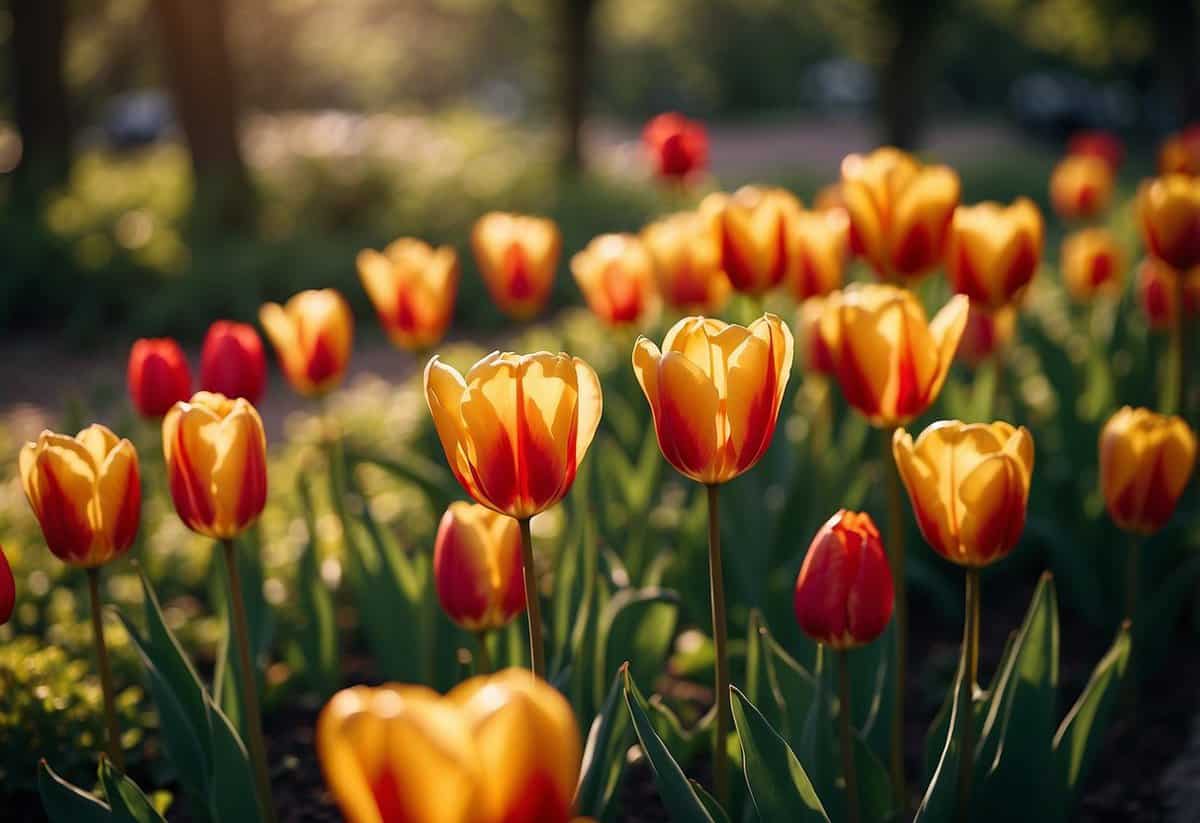Tulips Garden Tips: Best Practices for a Vibrant Bloom
Tulips are a favorite among garden enthusiasts due to their vibrant colors and elegant shapes. Whether you’re a novice gardener or have a seasoned green thumb, creating a beautiful tulip garden can be a rewarding endeavor. With the proper tips and care, your tulip garden can bloom beautifully each spring.

Your journey with tulips involves understanding the basics of planting, growing, and maintaining them. Tulips thrive in well-drained soil and a sunny location, making them relatively easy to care for. By following a few essential guidelines, you can enjoy a stunning display of tulips in your garden.
1) Choose a Sunny Spot

Tulips thrive best in sunny locations. They need at least six hours of sunlight each day. Full sun or partial shade works well.
Make sure the soil is well-drained to prevent waterlogging. If your garden has poor drainage, consider planting tulips in raised beds or containers.
If you live in a place with limited sunlight, grow lights can help provide the extra light tulips need.
2) Prepare Well-Drained Soil

Tulips thrive in well-drained soil. Start by loosening the soil to a depth of about 12-15 inches using a spade or garden fork. This helps roots grow and ensures good water drainage.
If your soil doesn’t drain well, think about adding sand or compost to improve its condition. Raised beds can also be a good solution for heavy soils.
Make sure the planting area gets plenty of sunlight. Tulips need at least six hours of sunlight a day, which keeps them healthy and blooming beautifully.
3) Plant in Early Fall

Planting tulips in early fall is key. The bulbs need time to establish roots before winter. You’ll want to plant them 6 to 8 weeks before your area’s first hard frost. Nighttime temperatures should be in the 40s. This helps ensure they get enough chill hours for spring blooming.
4) Use a Bulb Planter

Using a bulb planter makes planting tulips easier and faster.
A bulb planter helps you dig holes to the right depth. This way, your tulips will grow well.
It’s especially useful for planting many bulbs at once. Just push, twist, and lift to create the perfect hole.
Don’t forget to plant the bulbs with the pointed end facing up. This ensures they grow properly.
5) Space bulbs properly

When planting tulips, spacing is key. For a full look, place bulbs 2 to 3 inches apart. This helps create a dense, vibrant display.
If you want to spread your bulbs out more, 4 inches apart works too. This can save bulbs, but it won’t be as lush.
Try planting in groups for the best impact. It makes your garden look more lively and colorful.
6) Water Regularly

Watering tulips is key to their health. During the growing season, water them every 5-7 days. In their dormant period, usually every 2-3 weeks is enough for well-drained soil.
Once tulips bloom, they need more water. Try to water twice a week, making sure the water reaches 6-8 inches deep. This helps their roots grow strong.
Always avoid getting water directly on the bulbs to prevent rot. Focus on the soil around the base of the plants.
7) Mulch in Winter

Mulching is important for tulips, especially in winter. Cover the bulbs with 2-4 inches of aged mulch or finished compost. This layer helps protect the bulbs from cold temperatures and keeps the soil moist.
You can use shredded leaves, pine straw, or bark chips to cover your tulips. Check the mulch periodically to ensure it stays intact and adds more if needed. This keeps your tulips happy and healthy through the winter months.
8) Deadhead spent blooms

When your tulip flowers start to fade, it’s time to deadhead them.
Removing spent blooms helps the tulip bulbs store energy for the next year.
Use clean scissors or pruners to cut off the flower heads.
Make sure to remove only the flower and not the leaves, as the leaves are important for photosynthesis.
Leaving the foliage until it turns yellow before removing it will give your tulips the best chance to bloom again next spring.
9) Fertilize with bone meal

Bone meal is a wonderful fertilizer for your tulips. It is made from steamed animal bones that are ground into a fine powder. It provides essential nutrients like phosphorus which help your tulips grow strong and healthy.
You can add bone meal to the soil in the fall when planting new bulbs. This helps nourish the bulbs and supports root development. Just be careful not to overuse it, as too much can harm your tulips.
When using bone meal, aim for a mix that has an NPK rating of around 3-15-0. This ensures a good balance of nutrients for your tulips.
10) Protect from pests

To keep your tulips healthy, watch out for pests like caterpillars. They chew through leaves and flowers quickly. Look for rolled or chewed leaves and tiny eggs.
Another pest to monitor is aphids. These small insects can spread diseases. Regularly check your plants and use insecticidal soap if needed.
For preventing critters from digging up bulbs, consider planting deeper. Bury your bulbs at least three times their height. This makes it harder for them to be found by animals.
Sprinkling cayenne pepper around your plants can also deter pests. Reapply after rain for the best results.
By taking these steps, you can enjoy beautiful tulips in your garden.
Best Soil for Tulip Gardens

Choosing the right soil for your tulip garden is essential for healthy growth and vibrant blooms. You need to understand the types of soil and how to improve soil quality to create the perfect environment for your tulips.
Understanding Soil Types
Tulips thrive best in well-drained soil. Sandy loam is an excellent choice because it allows for proper drainage and air circulation around the roots. This soil type keeps the bulbs from sitting in water, which can cause rot.
Check the soil’s pH level, aiming for a range between 6.0 and 7.0. You can use a simple pH testing kit from a garden store to measure this. If your soil is too acidic or alkaline, adjust it with lime or sulfur as needed.
It’s important to know your soil texture. Clay soil tends to hold water and can cause problems for tulips. If you have clay soil, you might need to amend it with organic matter like compost to improve drainage.
Improving Soil Quality
To enhance the quality of your soil, start by adding organic matter such as compost or well-rotted manure. This helps improve soil structure and provides essential nutrients.
Mix the existing soil, amendments, and any additives like granular fertilizer (5-10-5 or 5-10-10) thoroughly before planting. This ensures the nutrients are evenly distributed and readily available to the bulbs.
Consider testing your soil for nutrient levels. Sometimes, adding specific nutrients like phosphorus can make a big difference in the health of your tulips. You can buy fertilizers especially made for bulbs, which usually contain a balanced mix of nutrients.
Maintaining good soil aeration is crucial. You might use tools like garden forks or aerators to loosen the soil periodically. This helps water penetrate better and roots to grow deeper and stronger.
Planting Tulips

For a beautiful display of tulips, you need to plant them at the right time and at the right depth. Ensuring good soil drainage and proper spacing is also crucial.
Optimal Planting Time
Tulips should be planted in the fall. Aim to plant them about six to eight weeks before the ground freezes. This gives the bulbs time to establish roots before winter.
In colder regions, September or October is usually ideal. In warmer areas, you might wait until November or even December. The goal is to plant when the soil temperature is below 60°F but above freezing.
Planting during this period helps tulips develop strong roots, ensuring vibrant blooms in the spring. Be careful not to plant too early, as the bulbs might sprout too soon and get damaged by the cold.
Correct Planting Depth
Planting tulips at the right depth is critical. Dig holes that are about three times the height of the bulbs, usually around 4 to 8 inches deep. This helps protect the bulbs from winter weather and gives them the strength to bloom.
Make sure to plant with the pointy end up. The depth varies slightly with soil type: in lighter, sandy soils, go a bit deeper. In heavier, clay soils, you can plant a bit shallower.
For a fuller display, space the bulbs about 2 to 5 inches apart. Planting many bulbs in a group can create a stunning effect in your garden. For more detailed tips, refer to this guide on tulip planting.







